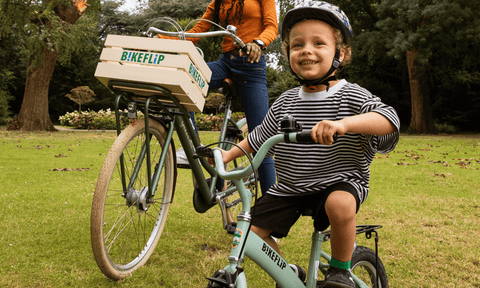Good brakes on a child's bike are not an unnecessary luxury. If you notice that your child has to squeeze the brake lever all the way before the bike starts to slow down a bit, or if the brakes make a squeaking sound, then it is time to adjust them. That may sound a bit complicated, but it really is not. Especially if you know what to look for.
What kind of brakes are on a children's bicycle?
Most children's bicycles are equipped with V-brakes: two brake arms with rubber blocks on either side of the wheel. When you pull the brake lever, these arms are pulled together, so that the blocks press against the rim of the wheel. If this system is not adjusted properly, the brakes will not work properly. For example, they will make noise, scrape, or hit the tire instead of the rim.
Check the brake pads
Always start with a quick inspection. Look at the brake pads: do they look worn? Are they almost completely smooth or are there cracks in them? Then it is time to replace them. You can do this with an Allen key: loosen them, put new ones on, tighten them. No rocket science.
Are the blocks still good, but do they not touch the rim properly? Then you need to adjust them. Loosen the bolt that holds the block a little, move the block so that it touches the metal part of the wheel exactly, and tighten it again. Make sure that the block does not touch the tire. That will wear the tire to pieces and will not give good braking power. You also want the block to touch the wheel straight and not crooked or at an odd angle.
Adjust the cable
If your blocks are set correctly, but you still have to squeeze the brake lever almost all the way before you notice anything, then the cable is probably too slack. You can solve this very easily by turning the small knob on the brake lever. It is a kind of silver-colored ring through which the cable runs. By turning it outwards a little, you tighten the cable a little. That immediately makes the braking a little tighter. A half to one turn is often enough. Then you turn the lock nut against it so that it does not turn back.
If that's not enough, you need to tighten the cable at the brake itself. That may sound a bit complicated, but it's really not that bad. You squeeze the two brake arms together with one hand, as if you were braking. At the bottom you can see that the brake cable is attached with a small screw (or bolt). You loosen that a little with an Allen key. Then you tighten the cable a little and tighten it again. Release the brake and test whether your child now has to squeeze less when braking. It should feel firm, but not so tight that your wheel immediately locks. A little play is actually good.
Set the system straight
Sometimes you notice that one brake pad hits the wheel before the other. Then the system is crooked. There is a small screw on the side of the brake arms. With this you can adjust the tension of the spring in the arm. Turn the screw on the side that remains a little further in and see if the arms then move at the same time. Often you only have to turn a quarter turn.
Finished!
If everything is set up correctly, the wheel should stop cleanly when you brake. Without squeaking, scraping or uneven braking. Turn the wheel with the bike upside down and then brake a few times. Does it work smoothly and do the brakes grip quickly and evenly? Then you have succeeded.
And you see? It wasn't that bad, right? It wasn't that bad? Then consider our sustainable children's bike subscription . With that, you never have to worry about squeaky or poorly functioning brakes and your child will always be on the right size bike.




